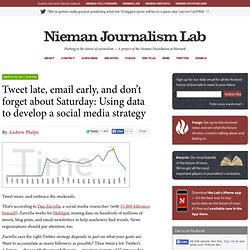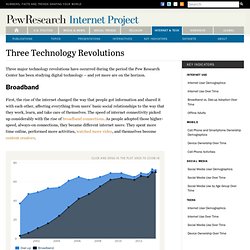

Tweet late, email early, and don’t forget about Saturday: Using data to develop a social media strategy. Tweet more, and embrace the weekends.

That’s according to Dan Zarrella, a social media researcher (with 33,000 followers himself). Zarrella works for HubSpot, mining data on hundreds of millions of tweets, blog posts, and email newsletters to help marketers find trends. News organizations should pay attention, too. Zarrella says the right Twitter strategy depends in part on what your goals are.
Want to accumulate as many followers as possible? It’s an inexact science, but at least it’s an attempt at science where so much social media strategy is driven by intuition. After collecting more than two years of data, Zarrella shared his findings Tuesday in a webinar called “The Science of Timing.” It turns out that time is often the afternoons, when blogs and news sites are slower, and the weekend, when they’re all but asleep. Retweet activity is highest late in the work day, between 2 and 5 p.m., and the sweet spot (tweet spot?) Here are the slides from Zarrella’s webinar: L’usage d’Internet et des TIC selon l’âge (étude) 4 jan 2011 par Julien POUGET Nous nous étions fait l’écho en 2009 d’une passionnante étude de l’institut Pew sur l’usage d’internet et des TIC par les différences générations (voir ici et là) A ma grande joie, l’institut vient de publier une version actualisée de l’étude.

Même si cette dernière a été réalisée aux États-Unis, ses résultats me semblent transposables à d’autres sociétés sociétés occidentales comme la France. Les principales conclusions de l’étude sont les suivantes : 1. Utilisation des réseaux sociaux (83% de taux d’utilisation pour les Y)Vidéo en ligne (80%)Utilisation de messageries instantanées (66%)Utilisation de petites annonces en ligne (64%)Écoute de musique en ligne (65%)Jeux vidéo (50%)Lecture de blogs (43%) 2. Visiter des sites gouvernementauxObtenir de l’information de nature financière 3.
Si le sujet vous intéresse, l’étude (en anglais) avec tous les chiffres est téléchargeable ici. Articles similaires: Trend Data. Three major technology revolutions have occurred during the period the Pew Research Center has been studying digital technology – and yet more are on the horizon.

Broadband First, the rise of the internet changed the way that people got information and shared it with each other, affecting everything from users’ basic social relationships to the way that they work, learn, and take care of themselves. The speed of internet connectivity picked up considerably with the rise of broadband connections. As people adopted those higher-speed, always-on connections, they became different internet users: They spent more time online, performed more activities, watched more video, and themselves become content creators. Mobile Second, mobile connectivity through cell phones, and later smartphones and tablet computers, made any time-anywhere access to information a reality for the vast majority of Americans. Social.